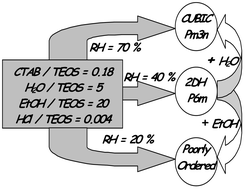A study is presented of the self-assembly process that takes place during CTAB-templated silica film formation through in situ SAXS, interferometry and water titration investigations during evaporation associated with dip coating under various conditions. This work shows that the quantity of water present in the film when the mesostructuration takes place depends on the relative humidity (RH) during deposition. Indeed, the system contains considerable quantities of water at high RH, while it loses water at low RH. The water content is demonstrated to be a critical parameter, as poorly ordered, 2D-hexagonal or 3D-cubic final structures are obtained, depending on the RH, in agreement with the general physico-chemical laws of CTAB mesophases. Furthermore, changing the RH or the solvent vapour pressure just after evaporation induces a film composition change and a potential mesostructure modification, evidencing a modulable steady state, during which the mesostructure can be modified by external influences. The present study pinpoints the role of processing conditions that are often considered secondary to chemical conditions. The conclusions of this study into the CTAB–TEOS system are also relevant to other surfactant-templated systems which undergo evaporation-controlled self-assembly.

You have access to this article
 Please wait while we load your content...
Something went wrong. Try again?
Please wait while we load your content...
Something went wrong. Try again?


 Please wait while we load your content...
Please wait while we load your content...